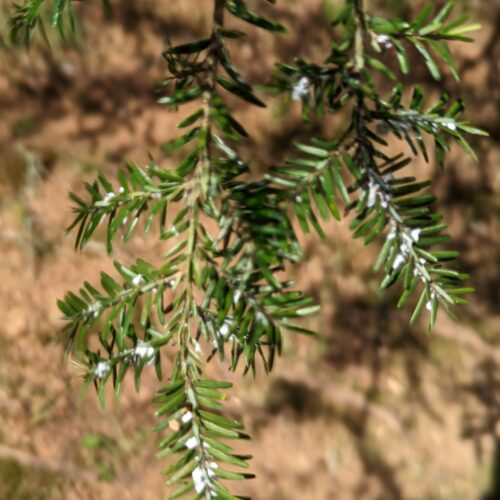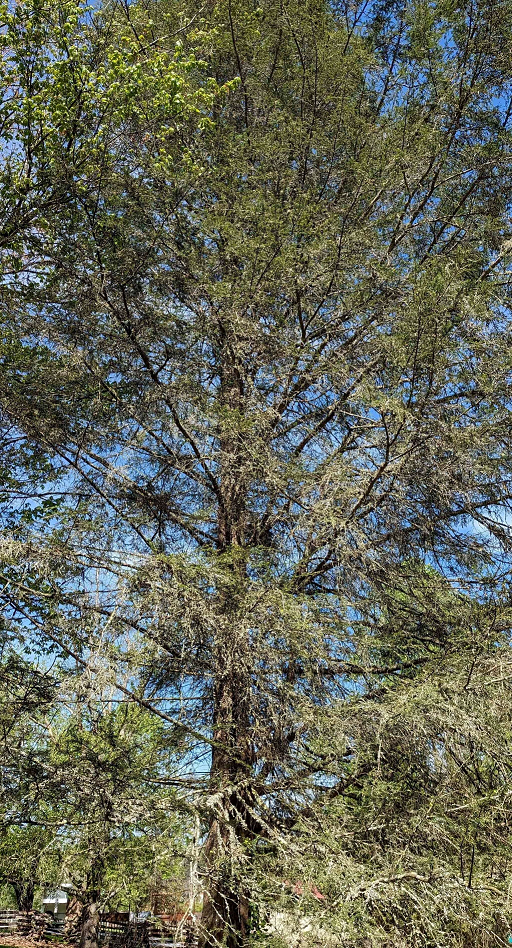The hemlock woolly adelgid (Adelges tsugae) is an insect native to Japan. It was first detected in the U.S. in Virginia early in the 1950s and now covers the entire range of eastern hemlock (Tsuga canadensis) throughout the Appalachians, Michigan and Nova Scotia. It also infests Carolina hemlock (T. caroliniana). Left untreated, hemlock will succumb to infestation in as little as 3 – 6 years.
Eastern hemlock is one of the few native evergreens that tolerates shady growing conditions. It is a riparian species, meaning that it’s found in wet, lowlands, often on stream and river banks. Healthy trees can live several hundred years, and some have referred to eastern hemlock as the redwood of the east!
Hemlock woolly adelgid (HWA) is a diminutive piercing sucking insect with a complex life cycle. It has two forms (i.e., progrediens and sistens). The overwintering adults lay clusters of eggs in a woolly mass called an ovisac. Crawlers hatch in spring after hemlock breaks bud and begins growth. The first instar nymphs settle on the new growth and undergo a summer aestivation (or dormancy). They resume growth in the fall and undergo three additional growth stages maturing into adults.
HWA insert their stylet into the xylem ray parenchyma, living cells in the hemlock that are high in sugar. As the population density increases, tree growth decreases. Signs of infestation are the white woolly masses on the twig tips, which may be observed in winter through early spring. Symptoms are a thinning crown, reduced growth and a grayish cast of the foliage.

Managing Hemlock Woolly Adelgid
Small trees can be sprayed with azadirachtin, insecticidal soap or horticultural oil. A note of caution using oils as they can cause injury to the foliage, especially in hot weather. Inject larger trees with an effective insecticide, such as imidacloprid. Some prefer to soil drench or soil inject the systemic insecticide, but I recommend tree injection using imidacloprid, such as IMA-jet (5% imidacloprid, Arborjet, Inc., Woburn, MA). Only use formulations labeled for tree injection, which are specifically formulated to move within the trees vascular system. Whichever treatment you use, always follow label directions for use.
Systemic tree injection treatment has certain advantages over soil drench or soil injection. The advantages include:
- Using less active material compared to soil treatment
- Eliminating runoff and leaching into the soil profile
- Reducing off-target risks to beneficial insects
The advantages of tree injection over canopy sprays include
- Tree injection protects the active ingredient from photolysis (the half-life of foliar applied imidacloprid is between 10 – 14 days)
- Tree injection eliminates drift
- Tree injection protects very large trees (sprays only reach 30 – 40 ft. into the canopy)
The persistence of the chemistry within the tree is based on two factors: the chemistry is protected from photo-degradation, and foliar retention. Unlike deciduous trees which lose their leaves every year, hemlock retains its needles for 3 to 6 years. Imidacloprid has systemic activity, which means that from the point of application, it moves upward into the canopy and growing points of the tree (that is, it is xylem mobile). Once in the foliage, it remains there, and is lost with leaf fall. Within the tree, imidacloprid undergoes hydrolysis, but the intermediate breakdown products are insecticidal. Our research has demonstrated tree protection, recovery and HWA control for 3 or more years.
Join us next week when we get back to maintaining plants in the landscape.
~ Signing off for now, Joe
References:
Doccola, JJ. 2021. Activity of Stem-Injected and Soil Applied Imidacloprid Against Hemlock Woolly Adelgid in the Great Smoky Mountains. Arboriculture & Urban Forestry. 47(1):25–33.
Doccola JJ, Hascher W, Aiken JJ, Wild PM. 2012. Treatment strategies using imidacloprid in hemlock woolly adelgid (Adelges tsugae Annand) infested eastern hemlock (Tsuga canandensis Carrière) trees. Arboriculture & Urban Forestry. 38(2):41-49.
Doccola JJ, Bristol EJ, Sifleet SS, Lyko J, Wild PM. 2007. Efficacy and duration of trunk-injected imidacloprid in the management of hemlock woolly adelgid (Adelges tsugae). Arboriculture & Urban Forestry. 33(1):12-21.

